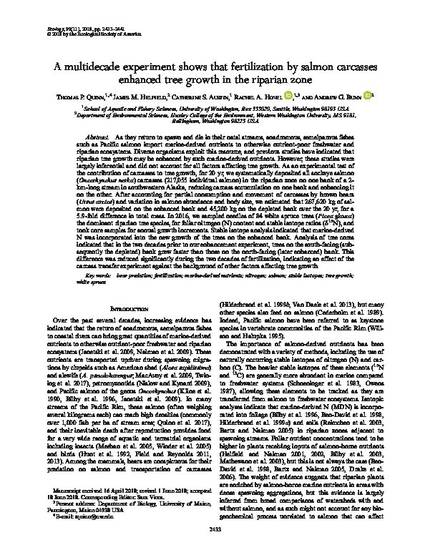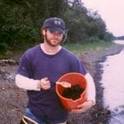
- Bear predation,
- Fertilization,
- Marine-derived nutrients,
- Nitrogen,
- Salmon,
- Stable isotopes,
- Tree growth,
- White spruce
As they return to spawn and die in their natal streams, anadromous, semelparous fishes such as Pacific salmon import marine‐derived nutrients to otherwise nutrient‐poor freshwater and riparian ecosystems. Diverse organisms exploit this resource, and previous studies have indicated that riparian tree growth may be enhanced by such marine‐derived nutrients. However, these studies were largely inferential and did not account for all factors affecting tree growth. As an experimental test of the contribution of carcasses to tree growth, for 20 yr, we systematically deposited all sockeye salmon (Oncorhynchus nerka) carcasses (217,055 individual salmon) in the riparian zone on one bank of a 2‐km‐long stream in southwestern Alaska, reducing carcass accumulation on one bank and enhancing it on the other. After accounting for partial consumption and movement of carcasses by brown bears (Ursus arctos) and variation in salmon abundance and body size, we estimated that 267,620 kg of salmon were deposited on the enhanced bank and 45,200 kg on the depleted bank over the 20 yr, for a 5.9‐fold difference in total mass. In 2016, we sampled needles of 84 white spruce trees (Picea glauca) the dominant riparian tree species, for foliar nitrogen (N) content and stable isotope ratios (δ15N), and took core samples for annual growth increments. Stable isotope analysis indicated that marine‐derived N was incorporated into the new growth of the trees on the enhanced bank. Analysis of tree cores indicated that in the two decades prior to our enhancement experiment, trees on the south‐facing (subsequently the depleted) bank grew faster than those on the north‐facing (later enhanced) bank. This difference was reduced significantly during the two decades of fertilization, indicating an effect of the carcass transfer experiment against the background of other factors affecting tree growth.
